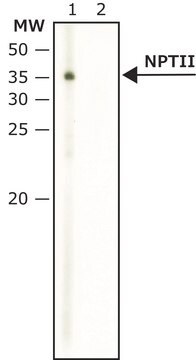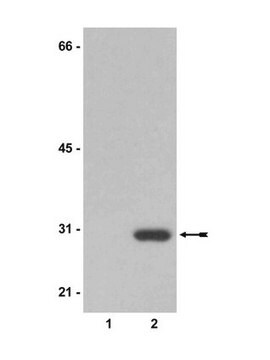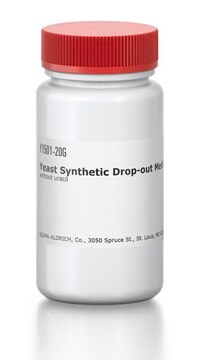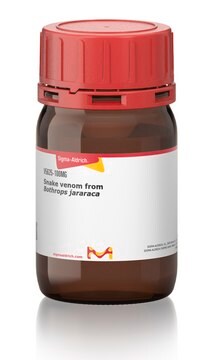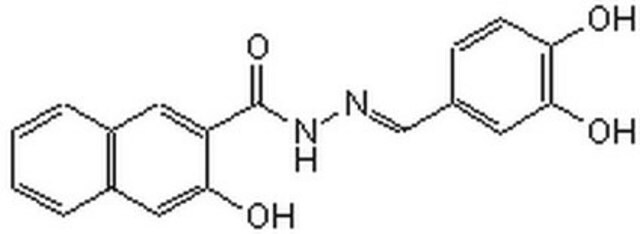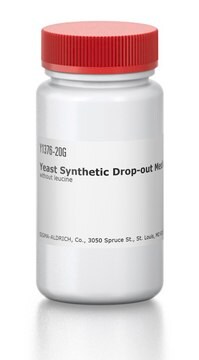176908
Antygen ochronny wąglika, Bacillus anthracis, Nicked, rekombinowany, B. anthracis
Synonim(y):
PA 63, PA 63
Zaloguj sięWyświetlanie cen organizacyjnych i kontraktowych
About This Item
Kod UNSPSC:
12352202
NACRES:
NA.77
Polecane produkty
Formularz
lyophilized
Poziom jakości
producent / nazwa handlowa
Calbiochem®
warunki przechowywania
OK to freeze
Warunki transportu
ambient
temp. przechowywania
2-8°C
Opis ogólny
Recombinant, Bacillus anthracis anthrax protective antigen (nicked) expressed in a specialized strain of B. anthracis. PA63 is the carboxyl-terminal 63-kDa fragment obtained by the proteolytic cleavage of the receptor-bound protective antigen (PA), one of the three proteins that comprise anthrax toxin. Unlike native PA, PA63 oligomerizes to form a ring-shaped heptamer that binds up to three copies of EF and/or LF competitively and with high affinity (Kd ~1 nM). Whereas native PA persists on the cell surface, the heptamer is endocytosed, presumably because oligomerization aggregates anthrax toxin receptor. The endocytosed toxic complexes are trafficked to endosomal compartments where the low pH causes the PA63 heptamer to insert into the membrane and form a water-filled channel.
Działania biochem./fizjol.
Cell permeable: no
Primary Target
EF and/or LF
EF and/or LF
Product does not compete with ATP.
Reversible: no
Ostrzeżenie
Toxicity: Standard Handling (A)
Postać fizyczna
Lyophilized from 100 mM NaCL, 10 mM BIS-Tris propane, 1.25% trehalose, pH 8.5.
Rekonstytucja
Following reconstitution aliquot and freeze (-20°C or- 70°C) for long term storage or refrigerate (4°C) for short-term (few hours) storage. Avoid rapid freeze-thaw cycles of solutions. Stock solutions are stable for up to 3 months at -20°C or -70°C.
Reconstitute in sterile 50% glycerol or sterile, distilled H₂O to a final concentration of 1 mg/ml. Addition of BSA to a concentration of 1 mg/ml may enhance stability.
Komentarz do analizy
Single major band at 63 kD by SDS-PAGE
Inne uwagi
Mogridge, J., et al. 2002. Proc. Natl. Acad. Sci. USA99, 7045.
Nassi, S., et al. 2002. Biochemistry41, 1445.
Singh, Y., et al. 1999. Infect. Immun.67, 1853.
Leppla, S.H. 1988. Methods Enzymol.165, 103.
Nassi, S., et al. 2002. Biochemistry41, 1445.
Singh, Y., et al. 1999. Infect. Immun.67, 1853.
Leppla, S.H. 1988. Methods Enzymol.165, 103.
Informacje prawne
CALBIOCHEM is a registered trademark of Merck KGaA, Darmstadt, Germany
Ta strona może zawierać tekst przetłumaczony maszynowo.
Kod klasy składowania
11 - Combustible Solids
Klasa zagrożenia wodnego (WGK)
WGK 1
Temperatura zapłonu (°F)
Not applicable
Temperatura zapłonu (°C)
Not applicable
Certyfikaty analizy (CoA)
Poszukaj Certyfikaty analizy (CoA), wpisując numer partii/serii produktów. Numery serii i partii można znaleźć na etykiecie produktu po słowach „seria” lub „partia”.
Masz już ten produkt?
Dokumenty związane z niedawno zakupionymi produktami zostały zamieszczone w Bibliotece dokumentów.
Nasz zespół naukowców ma doświadczenie we wszystkich obszarach badań, w tym w naukach przyrodniczych, materiałoznawstwie, syntezie chemicznej, chromatografii, analityce i wielu innych dziedzinach.
Skontaktuj się z zespołem ds. pomocy technicznej